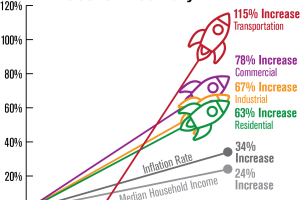There are two essential sorts of potential energy: gravitational potential energy and versatile potential energy.

The gravitational power of the Earth causes gravitational potential energy. At the point when an individual leaps from a high jump board, they land with much power into the pool underneath.
The World’s gravity utilizes the jumper’s gravitational power (their weight) to deliver the kinetic energy (development) that carries the jumper into the pool. At the highest point of the plunging board, we can discuss the jumper’s gravitational potential energy- Power to Choose .
This is no different for apples on trees, bicycles on top of a slope, a thrill ride holding back to slip, and a skydiver in a plane — all instances of the potential to do a measure of work.
Versatile potential energy happens when you stretch or pack something. An elastic band left on a sideboard has minimal potential energy. Assuming that you get it and stretch it, you have expanded accomplishing some work potential.
Assuming you discharge the elastic band, it might fly across the room or alarm the feline. You controlled the elastic band to expand its potential energy, which was then delivered as kinetic energy as it voyaged (movement) across the room. A toxophilite pulling back a bow and snaking a spring are further instances of potential energy.
Explicit Varieties:
Having characterized the fundamental kinds of energy, we can take a gander at additional particular models and conclude if they have kinetic or potential energy.
What Is the Potential Energy of an Electron?
Iotas are comprised of protons, neutrons, and electrons. Molecules can move potential and kinetic energy.
A molecule has a core, and electrons circle that core, which is kinetic energy. Assume we apply energy or strain to the iota. All things considered, it expands the electrons’ kinetic energy and they begin to move all the more rapidly. In the long run, the electrons leap out into a more extensive circle of the core. This electron has now put away this energy, this potential energy.
Eventually, the electron will deliver this potential energy, changing over into kinetic energy as it gets back to its past, more modest circle. The potential energy is delivered as noticeable light or intensity, the two sorts of kinetic energy. An electron’s all-out energy is the amount of its kinetic and potential energy.
Is Sound Energy Potential or Kinetic?
Sound energy comes in both potential and kinetic energy structures. Sound energy is delivered by vibrating objects as a wave.
An incredible illustration of sound energy is a tuning fork. At the point when it lies on the table, it can make sound energy, which is potential energy. When you strike it, it vibrates and emanates sound waves. These waves waver and travel, which is kinetic energy.
Sound goes multiple times quicker in water than in air. Adrift level, the speed of sound is roughly 767 miles each hour (1,230 kilometers each hour).
Nuclear power is likewise called heat energy. Recollect the sensitive electrons and particles from prior? Nuclear power is delivered when these particles and atoms are moving quicker. They are moving all the more rapidly due to the climb in temperature.
Contemplate a pot bubbling. The water particles move quicker as the water warms, and this development is kinetic energy. At the point when the water heats up, its steam moves. The nuclear power let out by the particles and atoms has created kinetic energy.
More models incorporate the intensity from an electrical warmer or when you put food on the stove to prepare; when you put cold milk in a hot beverage like tea, a portion of the tea’s warm intensity is passed to the milk.





